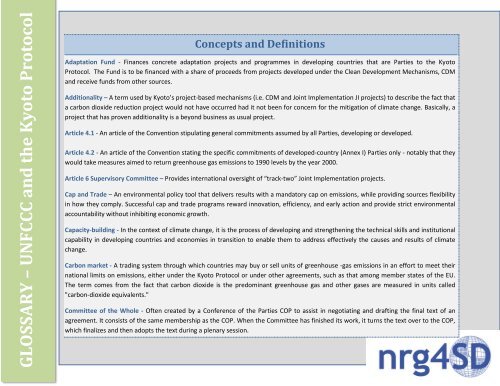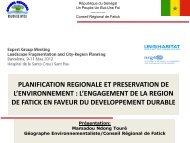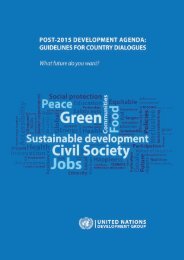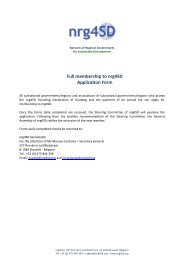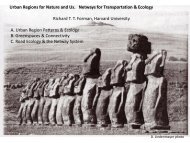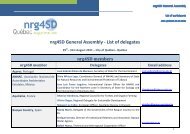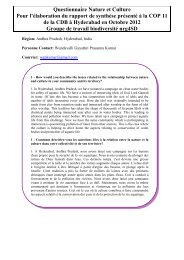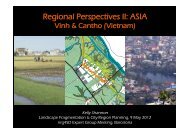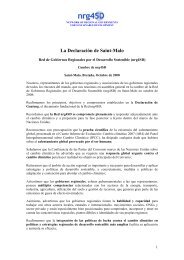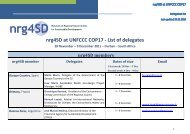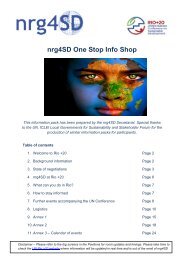Glossary - UNFCCC and the Kyoto Protocol - nrg4SD
Glossary - UNFCCC and the Kyoto Protocol - nrg4SD
Glossary - UNFCCC and the Kyoto Protocol - nrg4SD
Create successful ePaper yourself
Turn your PDF publications into a flip-book with our unique Google optimized e-Paper software.
GLOSSARY – <strong>UNFCCC</strong> <strong>and</strong> <strong>the</strong> <strong>Kyoto</strong> <strong>Protocol</strong>Concepts <strong>and</strong> DefinitionsAdaptation Fund - Finances concrete adaptation projects <strong>and</strong> programmes in developing countries that are Parties to <strong>the</strong> <strong>Kyoto</strong><strong>Protocol</strong>. The Fund is to be financed with a share of proceeds from projects developed under <strong>the</strong> Clean Development Mechanisms, CDM<strong>and</strong> receive funds from o<strong>the</strong>r sources.Additionality – A term used by <strong>Kyoto</strong>’s project-based mechanisms (i.e. CDM <strong>and</strong> Joint Implementation JI projects) to describe <strong>the</strong> fact thata carbon dioxide reduction project would not have occurred had it not been for concern for <strong>the</strong> mitigation of climate change. Basically, aproject that has proven additionality is a beyond business as usual project.Article 4.1 - An article of <strong>the</strong> Convention stipulating general commitments assumed by all Parties, developing or developed.Article 4.2 - An article of <strong>the</strong> Convention stating <strong>the</strong> specific commitments of developed-country (Annex I) Parties only - notably that <strong>the</strong>ywould take measures aimed to return greenhouse gas emissions to 1990 levels by <strong>the</strong> year 2000.Article 6 Supervisory Committee – Provides international oversight of “track-two” Joint Implementation projects.Cap <strong>and</strong> Trade – An environmental policy tool that delivers results with a m<strong>and</strong>atory cap on emissions, while providing sources flexibilityin how <strong>the</strong>y comply. Successful cap <strong>and</strong> trade programs reward innovation, efficiency, <strong>and</strong> early action <strong>and</strong> provide strict environmentalaccountability without inhibiting economic growth.Capacity-building - In <strong>the</strong> context of climate change, it is <strong>the</strong> process of developing <strong>and</strong> streng<strong>the</strong>ning <strong>the</strong> technical skills <strong>and</strong> institutionalcapability in developing countries <strong>and</strong> economies in transition to enable <strong>the</strong>m to address effectively <strong>the</strong> causes <strong>and</strong> results of climatechange.Carbon market - A trading system through which countries may buy or sell units of greenhouse -gas emissions in an effort to meet <strong>the</strong>irnational limits on emissions, ei<strong>the</strong>r under <strong>the</strong> <strong>Kyoto</strong> <strong>Protocol</strong> or under o<strong>the</strong>r agreements, such as that among member states of <strong>the</strong> EU.The term comes from <strong>the</strong> fact that carbon dioxide is <strong>the</strong> predominant greenhouse gas <strong>and</strong> o<strong>the</strong>r gases are measured in units called"carbon-dioxide equivalents."Committee of <strong>the</strong> Whole - Often created by a Conference of <strong>the</strong> Parties COP to assist in negotiating <strong>and</strong> drafting <strong>the</strong> final text of anagreement. It consists of <strong>the</strong> same membership as <strong>the</strong> COP. When <strong>the</strong> Committee has finished its work, it turns <strong>the</strong> text over to <strong>the</strong> COP,which finalizes <strong>and</strong> <strong>the</strong>n adopts <strong>the</strong> text during a plenary session.1
Copenhagen Accord – A document that delegates at <strong>the</strong> COP15 in Copenhagen ‘agreed to take note of’ at <strong>the</strong> final plenary in December2009.The Accord, drafted by, on <strong>the</strong> one h<strong>and</strong>, <strong>the</strong> US <strong>and</strong> on <strong>the</strong> o<strong>the</strong>r, in a united position as <strong>the</strong> BASIC countries (China, India, South Africa,<strong>and</strong> Brazil), is not legally binding <strong>and</strong> does not commit countries to agree to a binding successor to <strong>the</strong> <strong>Kyoto</strong> <strong>Protocol</strong>, whose present round endsin 2012.Decision - A formal agreement that (unlike a resolution) leads to binding actions. It becomes part of <strong>the</strong> agreed body of decisions that direct <strong>the</strong>work of <strong>the</strong> COP.Declaration - A non-binding political statement made by ministers attending a major meeting (e.g. <strong>the</strong> Geneva Ministerial Declaration of COP2).Entry into force - The point at which an intergovernmental agreement becomes legally binding - occurring at a pre-stated interval after a prestated<strong>and</strong> required number of ratifications by countries has been achieved. The Climate Change Convention required 50 ratifications to enterinto force. It now enters into force for each new Party 90 days after that Party ratifies <strong>the</strong> Convention.Friends of <strong>the</strong> Chair - Delegates called upon by <strong>the</strong> Chair (who takes into account <strong>the</strong> need for political balance among various interests) to assistin carrying out specific tasks.Hot air – Refers to <strong>the</strong> concern that some governments will be able to meet <strong>the</strong>ir targets for greenhouse gas emissions under <strong>the</strong> <strong>Kyoto</strong> <strong>Protocol</strong>with minimal effort <strong>and</strong> could <strong>the</strong>n flood <strong>the</strong> market with emissions credits, reducing <strong>the</strong> incentive for o<strong>the</strong>r countries to cut <strong>the</strong>ir own domesticemissions.Informal contact group - A group of delegates instructed by <strong>the</strong> President or a Chair to meet in private to discuss a specific matter in an effort toconsolidate different views, reach a compromise, <strong>and</strong> produce an agreed proposal, often in <strong>the</strong> form of a written text.<strong>Kyoto</strong> <strong>Protocol</strong> - An international agreement st<strong>and</strong>ing on its own, <strong>and</strong> requiring separate ratification by governments, but linked to <strong>the</strong> <strong>UNFCCC</strong>.The <strong>Kyoto</strong> <strong>Protocol</strong>, among o<strong>the</strong>r things, sets binding targets for <strong>the</strong> reduction of greenhouse gas emissions by industrialised countries.<strong>Kyoto</strong> mechanisms - Three market-based procedures established under <strong>the</strong> <strong>Kyoto</strong> <strong>Protocol</strong> to increase <strong>the</strong> flexibility <strong>and</strong> reduce <strong>the</strong> costs ofmaking greenhouse gas emissions cuts; <strong>the</strong>y are <strong>the</strong> Clean Development Mechanism CDM, Emissions Trading ET <strong>and</strong> Joint Implementation JI.Leakage - That portion of cuts in greenhouse gas emissions by developed countries -- countries trying to meet m<strong>and</strong>atory limits under <strong>the</strong> <strong>Kyoto</strong><strong>Protocol</strong> - that may reappear in o<strong>the</strong>r countries not bound by such limits. For example, multinational corporations may shift factories fromdeveloped countries to developing countries to escape restrictions on emissions.Major Groups – sectors of society recognised in Agenda 21 as having a substantive contribution to make to <strong>the</strong> achievement of a sustainablefuture. Groups identified in Agenda 21 include – Business <strong>and</strong> industry; Children <strong>and</strong> Youth; Farmers; Indigenous People; Local Authorities; Non-2
Voluntary commitments - A draft article considered during <strong>the</strong> negotiation of <strong>the</strong> <strong>Kyoto</strong> <strong>Protocol</strong> that would have permitted developingcountries to voluntarily adhere to legally binding emissions targets. The proposed language was dropped in <strong>the</strong> final phase of <strong>the</strong>negotiations. The issue remains important for some delegations <strong>and</strong> may be discussed at upcoming sessions of <strong>the</strong> Conference of <strong>the</strong> Parties.Vulnerability - The degree to which a system is susceptible to, or unable to cope with, adverse effects of climate change, including climatevariability <strong>and</strong> extremes. Vulnerability is a function of <strong>the</strong> character, magnitude, <strong>and</strong> rate of climate variation to which a system is exposed, itssensitivity, <strong>and</strong> its adaptive capacity.AcronymsAG13 Ad hoc Group on Article13AWG-KP Ad hoc Working Groupon fur<strong>the</strong>r commitments forAnnex I Parties under <strong>the</strong> <strong>Kyoto</strong><strong>Protocol</strong>AWG-LCA Ad hoc WorkingGroup on Long-termCooperative Action under <strong>the</strong>ConventionAOSIS Alliance of Small Isl<strong>and</strong>StatesBINGO Business <strong>and</strong> IndustryNGOsCACAM Central Asia, Caucasus<strong>and</strong> Moldova countriesDescriptionA subsidiary body (committee) created by <strong>the</strong> 1 st Conference of <strong>the</strong> Parties COP1 to explore how to helpgovernments overcome difficulties experienced in meeting <strong>the</strong>ir commitments under <strong>the</strong> Climate ChangeConvention (1995-1998).Established by Parties to <strong>the</strong> <strong>Protocol</strong> in Montreal (2005) to consider fur<strong>the</strong>r commitments of industrialisedcountries under <strong>the</strong> <strong>Kyoto</strong> <strong>Protocol</strong> for <strong>the</strong> period beyond 2012.Established in Bali in 2007 to conduct negotiations on a streng<strong>the</strong>ned international deal on climate change, set to beconcluded in Copenhagen in 2009. Now extended until end 2011.A coalition of small isl<strong>and</strong> <strong>and</strong> low-lying coastal countries that share similar development challenges <strong>and</strong> concernsabout <strong>the</strong> environment, especially <strong>the</strong>ir vulnerability to <strong>the</strong> adverse effects of global climate change.One of <strong>the</strong> nine constituencies recognised by <strong>the</strong> nine Major Groups which were established by Agenda 21.A group of countries that share similar challenges concerning climate change.4
CER Certified EmissionReductionA type of emissions unit or carbon credits issued by <strong>the</strong> Clean Development Mechanism.CDM Clean DevelopmentMechanismCOP Conference of <strong>the</strong> PartiesCOW Committee of <strong>the</strong> WholeCMP Conference of <strong>the</strong> Partiesserving as <strong>the</strong> Meeting of <strong>the</strong>PartiesDNA Designated NationalAuthorityA market-based mechanism under <strong>the</strong> <strong>Kyoto</strong> <strong>Protocol</strong> through which developed countries may finance greenhousegasemission reduction or removal projects in developing countries, <strong>and</strong> receive credits for doing so which <strong>the</strong>y mayapply towards meeting m<strong>and</strong>atory limits on <strong>the</strong>ir own emissions.The Convention’s supreme body. It currently meets once a year to review <strong>the</strong> Convention's progress. The word‘conference’ is not used here in <strong>the</strong> sense of ‘meeting’ but ra<strong>the</strong>r of ‘association,’ which explains <strong>the</strong> seeminglyredundant expression ‘fourth session of <strong>the</strong> Conference of <strong>the</strong> Parties.’Often created by a COP to aid in negotiating text. It consists of <strong>the</strong> same membership as <strong>the</strong> COP. When <strong>the</strong>Committee has finished its work, it turns <strong>the</strong> text over to <strong>the</strong> COP, which finalises <strong>and</strong> <strong>the</strong>n adopts <strong>the</strong> text during aplenary session.The Convention’s supreme body is <strong>the</strong> COP, which serves as <strong>the</strong> meeting of <strong>the</strong> Parties to <strong>the</strong> <strong>Kyoto</strong> <strong>Protocol</strong>. Thesessions of <strong>the</strong> COP <strong>and</strong> <strong>the</strong> CMP are held during <strong>the</strong> same period to reduce costs <strong>and</strong> improve coordinationbetween <strong>the</strong> Convention <strong>and</strong> <strong>the</strong> <strong>Protocol</strong>.The body granted responsibility by a Party to authorise <strong>and</strong> approve participation in CDM projects.ENGO Environmental NGO One of <strong>the</strong> nine constituencies recognised by <strong>the</strong> nine Major Groups which were established by Agenda 21.EU ETSEuropean Union EmissionsTrading SystemEUA European Union AllowanceITL International TransactionLogJI Joint implementationA cornerstone of <strong>the</strong> EU's policy to combat climate change <strong>and</strong> its key tool for reducing industrial greenhouse gasemissions cost-effectively. Being <strong>the</strong> first <strong>and</strong> biggest international scheme for <strong>the</strong> trading of greenhouse gasemission allowances, it covers some 11,000 power stations <strong>and</strong> industrial plants in 30 countries.These are carbon credits used in <strong>the</strong> EU ETS, which are issued by EU Member States into Member State Registryaccounts. By April 30 of each year, operators of installations covered by <strong>the</strong> EU ETS must surrender an EU Allowancefor each ton of CO 2 emitted in <strong>the</strong> previous year.The ITL verifies transactions proposed by registries to ensure <strong>the</strong>y are consistent with rules agreed under <strong>the</strong> <strong>Kyoto</strong><strong>Protocol</strong>.A mechanism under <strong>the</strong> <strong>Kyoto</strong> <strong>Protocol</strong> where a developed country can receive "emissions reduction units" when it5
helps to finance projects that reduce net greenhouse-gas emissions in ano<strong>the</strong>r developed country. An Annex I Partymust meet specific eligibility requirements to participate in joint implementation.JLG Joint Liaison GroupGWP Global warming potentialGOOS Global Ocean ObservingSystemGHGs Greenhouse gasesG8 Group of 8 (<strong>and</strong> <strong>the</strong> EU)G20 Group of 20 FinanceMinisters <strong>and</strong> Central BankGovernorsG77 Group of 77 <strong>and</strong> ChinaGRULAC Group of LatinAmerican <strong>and</strong> Caribbean StatesGEF Global Environment FacilityGroup of representatives of <strong>UNFCCC</strong>, CBD, <strong>and</strong> UNCCD Secretariats set up to explore common activities to confrontproblems related to climate change, biodiversity <strong>and</strong> desertification.An index representing <strong>the</strong> combined effect of <strong>the</strong> differing times greenhouse gases remain in <strong>the</strong> atmosphere <strong>and</strong><strong>the</strong>ir relative effectiveness in absorbing outgoing infrared radiation.A permanent global system for observations, modeling <strong>and</strong> analysis of marine <strong>and</strong> ocean variables to supportoperational ocean services worldwide. It provides accurate descriptions of <strong>the</strong> present state of <strong>the</strong> oceans, includingliving resources; continuous forecasts of <strong>the</strong> future conditions of <strong>the</strong> sea for as far ahead as possible, <strong>and</strong> <strong>the</strong> basisfor forecasts of climate change.The atmospheric gases responsible for causing global warming <strong>and</strong> climate change. The major GHGs are carbondioxide (CO2), methane (CH4) <strong>and</strong> nitrous oxide (N20).A forum created by France in 1975 for <strong>the</strong> governments of <strong>the</strong> 8 major economies – Canada, France, Germany, Italy,Japan, Russian Federation, UK <strong>and</strong> USA. The EU is represented within <strong>the</strong> G8, but cannot host or chair.A group of finance ministers <strong>and</strong> central bank governors from 20 major economies: 19 countries plus <strong>the</strong> EU. TheG20 was proposed for cooperation <strong>and</strong> consultation on matters affecting <strong>the</strong> international financial system. Itstudies, reviews, <strong>and</strong> promotes discussion (among key industrial <strong>and</strong> emerging market countries) of policy issuesrelating to <strong>the</strong> promotion of international financial stability, <strong>and</strong> seeks to address issues that go beyond <strong>the</strong>responsibilities of any one organisation.A large negotiating alliance of developing countries that focuses on numerous international topics, includingclimate change. Founded in 1967 under <strong>the</strong> auspices of <strong>the</strong> UN Conference on Trade <strong>and</strong> Development (UNCTAD).It seeks to harmonise <strong>the</strong> negotiating positions of its 131 member states.One of several unofficial Regional Groups in <strong>the</strong> UN that act as voting blocs <strong>and</strong> negotiation forums.An independent financial organisation that provides grants to developing countries for projects that benefit <strong>the</strong>global environment <strong>and</strong> promote sustainable livelihoods in local communities. The Parties to <strong>the</strong> Conventionassigned operation of <strong>the</strong> financial mechanism to <strong>the</strong> Global Environment Facility on an on-going basis, subject toreview every four years.6
OrganisationPP Project ParticipationQELROs Quantified EmissionsLimitation <strong>and</strong> ReductionCommitmentsREDD Reducing Emissions fromDeforestation <strong>and</strong> ForestDegradationRINGO Research <strong>and</strong>independent NGOsSCCF Special Climate ChangeFundgovernment. The term is usually used by governments to refer to entities that have no government status.A party or public or private entity authorised by a Party of <strong>the</strong> <strong>Kyoto</strong> <strong>Protocol</strong> to participate in <strong>the</strong> development of<strong>the</strong> project mechanisms.Legally binding targets <strong>and</strong> timetables under <strong>the</strong> <strong>Kyoto</strong> <strong>Protocol</strong> for <strong>the</strong> limitation or reduction of greenhouse-gasemissions by developed countries.An effort to create a financial value for <strong>the</strong> carbon stored in forests, offering incentives for developing countries toreduce emissions from forested l<strong>and</strong>s <strong>and</strong> invest in low-carbon paths to sustainable development. ‘REDD+’ goesbeyond deforestation <strong>and</strong> forest degradation, <strong>and</strong> includes <strong>the</strong> role of conservation, sustainable management offorests <strong>and</strong> enhancement of forest carbon stocks.One of <strong>the</strong> nine constituencies recognised by <strong>the</strong> nine Major Groups which were established by Agenda 21.Established to finance projects relating to adaptation; technology transfer <strong>and</strong> capacity building; energy, transport,industry, agriculture, forestry <strong>and</strong> waste management; <strong>and</strong> economic diversification. This fund shouldcomplement o<strong>the</strong>r funding mechanisms for <strong>the</strong> implementation of <strong>the</strong> Convention.TUNGO Trade union NGO One of <strong>the</strong> nine constituencies recognised by <strong>the</strong> nine Major Groups which were established by Agenda 21.<strong>UNFCCC</strong> United NationsFramework Convention onClimate ChangeThe Convention on Climate Change sets an overall framework for intergovernmental efforts to tackle <strong>the</strong> challengeposed by climate change. It recognises that <strong>the</strong> climate system is a shared resource whose stability can beaffected by industrial <strong>and</strong> o<strong>the</strong>r emissions of carbon dioxide <strong>and</strong> o<strong>the</strong>r greenhouse gases.WEOG Western European <strong>and</strong>O<strong>the</strong>rs GroupOne of several unofficial Regional Groups in <strong>the</strong> UN that act as voting blocs <strong>and</strong> negotiation forums.YOUNGO Youth NGO One of <strong>the</strong> nine constituencies recognised by <strong>the</strong> nine Major Groups which were established by Agenda 21.Click here for <strong>the</strong> full list of <strong>UNFCCC</strong> climate change acronyms <strong>and</strong> definitions.<strong>nrg4SD</strong> Rough Guide to <strong>UNFCCC</strong> <strong>and</strong> <strong>the</strong> <strong>Kyoto</strong> <strong>Protocol</strong> here© <strong>nrg4SD</strong> – The Network of Regional Governments for Sustainable Development – April 2011. All rights reserved.www.nrg4sd.org • 20, Bvd. Roi Albert II-Köning Albert II-laan, B-1000 Brussels, Belgium • nrg4sd@nrg4sd.org8


